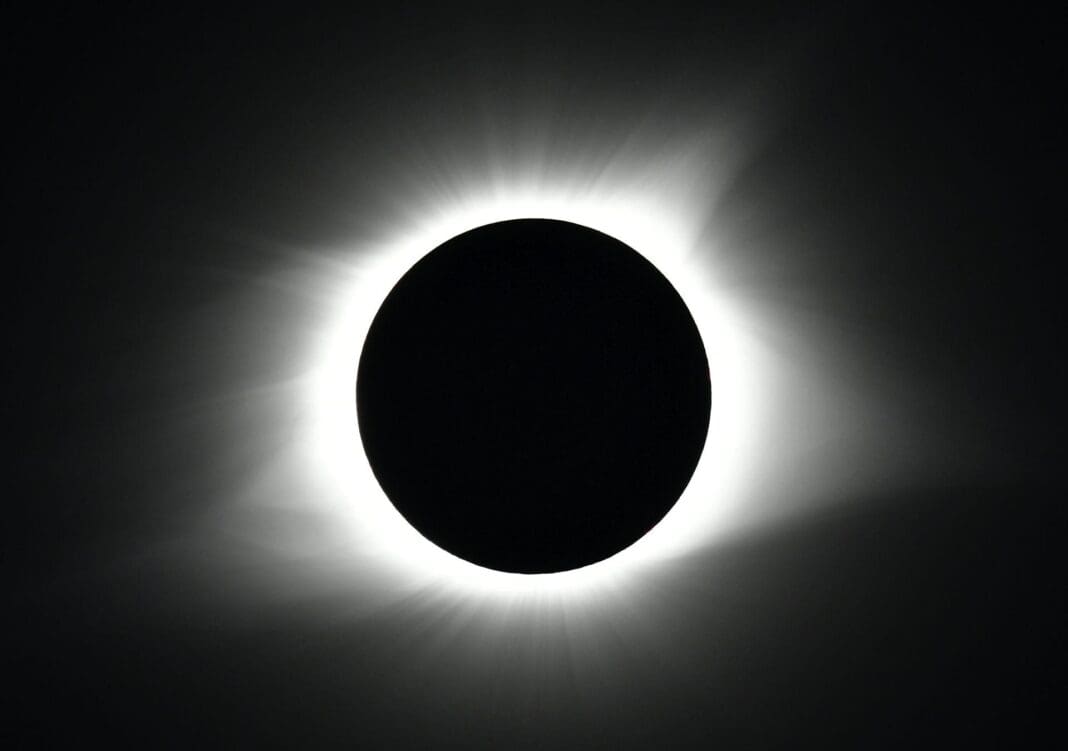On April 8, 2024, millions across the U.S. will have the once-in-a-lifetime chance to view a total solar eclipse. Cities including Austin, Texas; Buffalo, New York; and Cleveland, Ohio, will have a direct view of this rare cosmic event that lasts for just a few hours.
While you can see many astronomical events, such as comets and meteor showers, from anywhere on Earth, eclipses are different. You need to travel to what’s called the path of totality to experience the full eclipse. Only certain places get an eclipse’s full show, and that’s because of scale.
The relatively small size of the Moon and its shadow make eclipses truly once-in-a-lifetime opportunities. On average, total solar eclipses are visible somewhere on Earth once every few years. But from any one location on Earth, it is roughly 375 years between solar eclipses.
I’m an astronomer, but I have never seen a total solar eclipse, so I plan to drive to Erie, Pennsylvania, in the path of totality, for this one. This is one of the few chances I have to see a total eclipse without making a much more expensive trip to someplace more remote. Many people have asked me why nearby eclipses are so rare, and the answer is related to the size of the Moon and its distance from the Sun.
You can observe a solar eclipse when the Moon passes in front of the Sun, blocking some or all of the Sun from view. For people on Earth to be able to see an eclipse, the Moon, while orbiting around the Earth, must lie exactly along the observer’s line of sight with the Sun. Only some observers will see an eclipse, though, because not everyone’s view of the Sun will be blocked by the Moon on the day of an eclipse.
The fact that solar eclipses happen at all is a bit of a numerical coincidence. It just so happens that the Sun is approximately 400 times larger than the Moon and also 400 times more distant from the Earth.
So, even though the Moon is much smaller than the Sun, it is just close enough to Earth to appear the same size as the Sun when seen from Earth.
For example, your pinky finger is much, much smaller than the Sun, but if you hold it up at arm’s length, it appears to your eye to be large enough to block out the Sun. The Moon can do the same thing – it can block out the Sun if it’s lined up perfectly with the Sun from your point of view.
When the Earth, Moon and Sun line up perfectly, the Moon casts a shadow onto the Earth. Since the Moon is round, its shadow is round as it lands on Earth. The only people who see the eclipse are those in the area on Earth where the shadow lands at a given moment.
The Moon is continuously orbiting around the Earth, so as time goes on during the eclipse, the Moon’s shadow moves over the face of the Earth. Its shadow ends up looking like a thick line that can cover hundreds of miles in length. Astronomers call that line the path of totality.
From any given location along the path of totality, an observer can see the Sun completely eclipsed for a few minutes. Then, the shadow moves away from that location and the Sun slowly becomes more and more visible.
Solar eclipses don’t happen every single time the Moon passes in between Earth and the Sun. If that were the case, there would be a solar eclipse every month.
If you could float above the Earth’s North Pole and see the Moon’s orbit from above, you would see the Moon line up with the Sun once every time it orbits around the Earth, which is approximately once per month. From this high point of view, it looks like the Moon’s shadow should land on Earth every orbit.
However, if you could shift your perspective to look at the Moon’s orbit from the orbital plane, you would see that the Moon’s orbit is tilted by about 5 degrees compared with Earth’s orbit around the Sun. This tilt means that sometimes the Moon is too high and its shadow passes above the Earth, and sometimes the Moon is too low and its shadow passes below the Earth. An eclipse happens only when the Moon is positioned just right and its shadow lands on the Earth.
As time goes on, the Earth and the Moon continue spinning, and eventually the Moon aligns with Earth’s orbit around the Sun at the same moment the Moon passes between the Sun and the Earth.
While only certain cities are in the path of totality for this April’s eclipse, the entire U.S. is still close enough to this path that observers outside of the path of totality will see a partial eclipse. In those locations, the Moon will appear to pass in front of part of the Sun, leaving a crescent shape of the Sun still visible at the moment of maximum eclipse.
This article is republished from The Conversation, a nonprofit, independent news organization bringing you facts and trustworthy analysis to help you make sense of our complex world. It was written by: Christopher Palma, Penn State
Read more: How ancient cultures explained eclipses Astro-tourism − chasing eclipses, meteor showers and elusive dark skies from Earth What would a solar eclipse look like from the Moon? An astronomer answers that and other total eclipse questions
Christopher Palma does not work for, consult, own shares in or receive funding from any company or organization that would benefit from this article, and has disclosed no relevant affiliations beyond their academic appointment.













